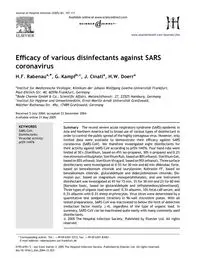
2005 Efficacy of various disinfectants against SARS coronavirus PDF
Preview 2005 Efficacy of various disinfectants against SARS coronavirus
Efficacy of various disinfectants against SARS coronavirus H.F. Rabenaua,*, G. Kampfb,c, J. Cinatla, H.W. Doerra aInstitut fu¨r Medizinische Virologie, Klinikum der Johann Wolfgang Goethe-Universita¨t Frankfurt, Paul-Ehrlich-Str. 40, 60596 Frankfurt, Germany bBode Chemie GmbH & Co., Scientific Affairs, Melanchthonstr. 27, 22525 Hamburg, Germany cInstitut fu¨r Hygiene und Umweltmedizin, Ernst-Moritz-Arndt Universita¨t Greifswald, Walther-Rathenau-Str. 49a, 17489 Greifswald, Germany Received 5 July 2004; accepted 23 December 2004 Available online 31 May 2005 KEYWORDS SARS-CoV; Disinfectants; Virucidal activity; prEN 14476 Summary The recent severe acute respiratory syndrome (SARS) epidemic in Asia and Northern America led to broad use of various types of disinfectant in order to control the public spread of the highly contagious virus. However, only limited data were available to demonstrate their efficacy against SARS coronavirus (SARS-CoV). We therefore investigated eight disinfectants for their activity against SARS-CoV according to prEN 14476. Four hand rubs were tested at 30 s (Sterillium, based on 45% iso-propanol, 30% n-propanol and 0.2% mecetroniumetilsulphate;SterilliumRub,basedon80%ethanol;SterilliumGel, based on 85%ethanol;Sterillium Virugard,basedon95%ethanol). Three surface disinfectants were investigated at 0.5% for 30 min and 60 min (Mikrobac forte, based on benzalkonium chloride and laurylamine; Kohrsolin FF, based on benzalkonium chloride, glutaraldehyde and didecyldimonium chloride; Dis- mozon pur, based on magnesium monoperphthalate), and one instrument disinfectant was investigated at 4% for 15 min, 3% for 30 min and 2% for 60 min [Korsolex basic, based on glutaraldehyde and (ethylenedioxy)dimethanol]. Three types of organic load were used: 0.3% albumin, 10% fetal calf serum, and 0.3% albumin with 0.3% sheep erythrocytes. Virus titres were determined by a quantitative test (endpoint titration) in 96-well microtitre plates. With all tested preparations, SARS-CoV was inactivated to below the limit of detection (reduction factor mostly R4), regardless of the type of organic load. In summary, SARS-CoV can be inactivated quite easily with many commonly used disinfectants. Q 2005 The Hospital Infection Society. Published by Elsevier Ltd. All rights reserved. Journal of Hospital Infection (2005) 61, 107–111 www.elsevierhealth.com/journals/jhin 0195-6701/$ - see front matter Q 2005 The Hospital Infection Society. Published by Elsevier Ltd. All rights reserved. doi:10.1016/j.jhin.2004.12.023 * Corresponding author. Tel.: C49 69 6301 5312; fax: C49 69 6301 83061. E-mail address:
